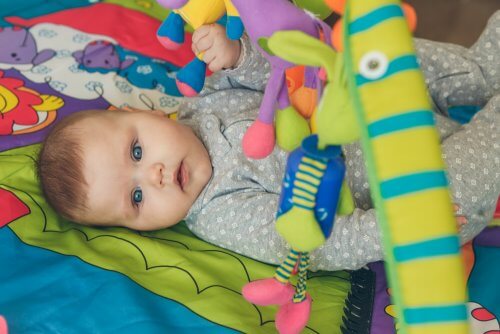Early Stimulation Exercises for Children

Early stimulation exercises can help your children develop greater psychomotor and cognitive capacities.
Early stimulation for children, or early attention, can be applied to kids ranging from newborns to six-year-olds. What’s important is that it takes place while children’s personalities are still developing.
It’s recommended that you begin these early stimulation exercises when the child is still a newborn. Starting at this young age can help children develop abilities that will become stronger as time goes on.
Relevant areas in early stimulation
There are four areas involved in early stimulation exercises:
- Fine motor skills. The development of fine motor skills involves the hands and fingers. This becomes relevant once babies begin to discover their hands’ movements.
- Gross motor skills. This refers to the other parts of the body, including the arms, the legs, and the body’s movement in general.
- Social-emotional. This area involves the ability to relate to others (social) and the ability to show emotions (emotional).
- Language. This area encompasses the ability to speak and respond.
The intensity of the early stimulation exercises will depend on the child’s age. If you’re dealing with a newborn, start softly and increase the intensity with age.
Early stimulation exercises
To explain some of the most popular early stimulation exercises, we’ll use three different categories in terms of age. As we’ve already mentioned, the exercises should vary in intensity depending on the child’s age.

Early stimulation exercises for newborns
- To help develop children’s grip on objects, hand them one that makes noise, like a rattle. Move it in both directions so that they can repeat the exercise.
- To encourage facial stimulation, place your fingers in the middle of their forehead, nose or lips and move them apart gently on both sides.
- Give them bright-colored objects that will catch their attention.
- Kissing, caressing and talking to your children in a loving tone will help develop their social side.
- Beginning at four months old, body movements come into play. Babies can now roll onto their backs and move forward a few meters.
- Stretch and flex their arms and legs.
- As the babies grow, these exercises should continue in a similar but more complex fashion.
Early stimulation exercises for children ages one to three
By the time children are one year old, it’s time for them to start discovering their surroundings and develop their sense of perception.
- At this age, it’s also a good idea for children to start moving and standing up on their own. Get their attention by grabbing toys and placing them nearby so that they can go get them.
- Identification games will help children begin to learn information. Examples include: body parts, numbers from 1 to 10, and colors.
- If you use songs as part of these games, it can help children develop their memory.
- Help them learn simple tasks like picking up their toys, asking to go to the bathroom, and getting dressed and undressed on their own. These small acts will help them acquire good behavioral habits.

Early stimulation exercises for children ages three to six
- Use simple puzzles to teach them how to begin to fit pieces together. This will allow their thinking processes to develop.
- Use music to encourage body movement. Then, teach them simple dances that they can easily remember.
- Let them draw and ask them what they’re drawing. This will allow them to explain what they’re feeling in that moment.
- Teach them simple tasks like throwing things in the trash and taking a spoon from the drawer.
- Develop their imaginations by using a stuffed animal as the protagonist of an improvized story.
- How children relate to others is very important. Talking and playing with each other is essential to their development.
Early stimulation exercises can help your children develop greater psychomotor and cognitive capacities.
Early stimulation for children, or early attention, can be applied to kids ranging from newborns to six-year-olds. What’s important is that it takes place while children’s personalities are still developing.
It’s recommended that you begin these early stimulation exercises when the child is still a newborn. Starting at this young age can help children develop abilities that will become stronger as time goes on.
Relevant areas in early stimulation
There are four areas involved in early stimulation exercises:
- Fine motor skills. The development of fine motor skills involves the hands and fingers. This becomes relevant once babies begin to discover their hands’ movements.
- Gross motor skills. This refers to the other parts of the body, including the arms, the legs, and the body’s movement in general.
- Social-emotional. This area involves the ability to relate to others (social) and the ability to show emotions (emotional).
- Language. This area encompasses the ability to speak and respond.
The intensity of the early stimulation exercises will depend on the child’s age. If you’re dealing with a newborn, start softly and increase the intensity with age.
Early stimulation exercises
To explain some of the most popular early stimulation exercises, we’ll use three different categories in terms of age. As we’ve already mentioned, the exercises should vary in intensity depending on the child’s age.

Early stimulation exercises for newborns
- To help develop children’s grip on objects, hand them one that makes noise, like a rattle. Move it in both directions so that they can repeat the exercise.
- To encourage facial stimulation, place your fingers in the middle of their forehead, nose or lips and move them apart gently on both sides.
- Give them bright-colored objects that will catch their attention.
- Kissing, caressing and talking to your children in a loving tone will help develop their social side.
- Beginning at four months old, body movements come into play. Babies can now roll onto their backs and move forward a few meters.
- Stretch and flex their arms and legs.
- As the babies grow, these exercises should continue in a similar but more complex fashion.
Early stimulation exercises for children ages one to three
By the time children are one year old, it’s time for them to start discovering their surroundings and develop their sense of perception.
- At this age, it’s also a good idea for children to start moving and standing up on their own. Get their attention by grabbing toys and placing them nearby so that they can go get them.
- Identification games will help children begin to learn information. Examples include: body parts, numbers from 1 to 10, and colors.
- If you use songs as part of these games, it can help children develop their memory.
- Help them learn simple tasks like picking up their toys, asking to go to the bathroom, and getting dressed and undressed on their own. These small acts will help them acquire good behavioral habits.

Early stimulation exercises for children ages three to six
- Use simple puzzles to teach them how to begin to fit pieces together. This will allow their thinking processes to develop.
- Use music to encourage body movement. Then, teach them simple dances that they can easily remember.
- Let them draw and ask them what they’re drawing. This will allow them to explain what they’re feeling in that moment.
- Teach them simple tasks like throwing things in the trash and taking a spoon from the drawer.
- Develop their imaginations by using a stuffed animal as the protagonist of an improvized story.
- How children relate to others is very important. Talking and playing with each other is essential to their development.
All cited sources were thoroughly reviewed by our team to ensure their quality, reliability, currency, and validity. The bibliography of this article was considered reliable and of academic or scientific accuracy.
- Barreno-Salinas, Z; Macías-Alvarado, J. Estimulación temprana para potencia la inteligencia psicomotriz: importancia y relación. Revista Ciencia UNEMI Vol. 8 – Nº 15, Septiembre 2015, pp. 110 – 118. ISSN: 1390 – 4272.
- La estimulación temprana y su importancia. Temas para la educación. Revista digital para profesionales de la enseñanza. Nº 17. Noviembre 2011. Federación de Enseñanza de CC.OO de Andalucía. ISNN: 1989-4023. Dep Leg: GR 2786-2008. [En línea] Disponible en: https://www.feandalucia.ccoo.es/docu/p5sd8727.pdf
- Sánchez, E. El poder de la estimulación sensorial. La mente es maravillosa. [En línea] Disponible en: https://lamenteesmaravillosa.com/el-poder-de-la-estimulacion-sensorial/
This text is provided for informational purposes only and does not replace consultation with a professional. If in doubt, consult your specialist.








